NURS8730 Case Study: Critical Analysis of Diabetes Management Plan
VerifiedAdded on 2023/06/09
|11
|3127
|351
Case Study
AI Summary
This case study analyzes the diabetes management of Mr. Smith, a 58-year-old male diagnosed with type 2 diabetes mellitus in 2010. The study reviews his medical history, including hypertension, obesity, and smoking, and examines his current medications (Atenolol and Metformin) and recent blood test results. It discusses the diagnostic process, relevant tests like HbA1c and fasting plasma glucose, and the impact of hyperglycemia and insulin resistance on his health. The analysis extends to Mr. Smith's lifestyle, highlighting his adherence to dietary recommendations and exercise, and the support provided by his family. The case study also touches on the role of Diabetes Australia in promoting healthy lifestyles and providing resources for diabetes management, emphasizing the importance of lifestyle changes and proper medical care in controlling the condition and preventing cardiovascular complications; this assignment is available on Desklib with solved assignments and past papers.
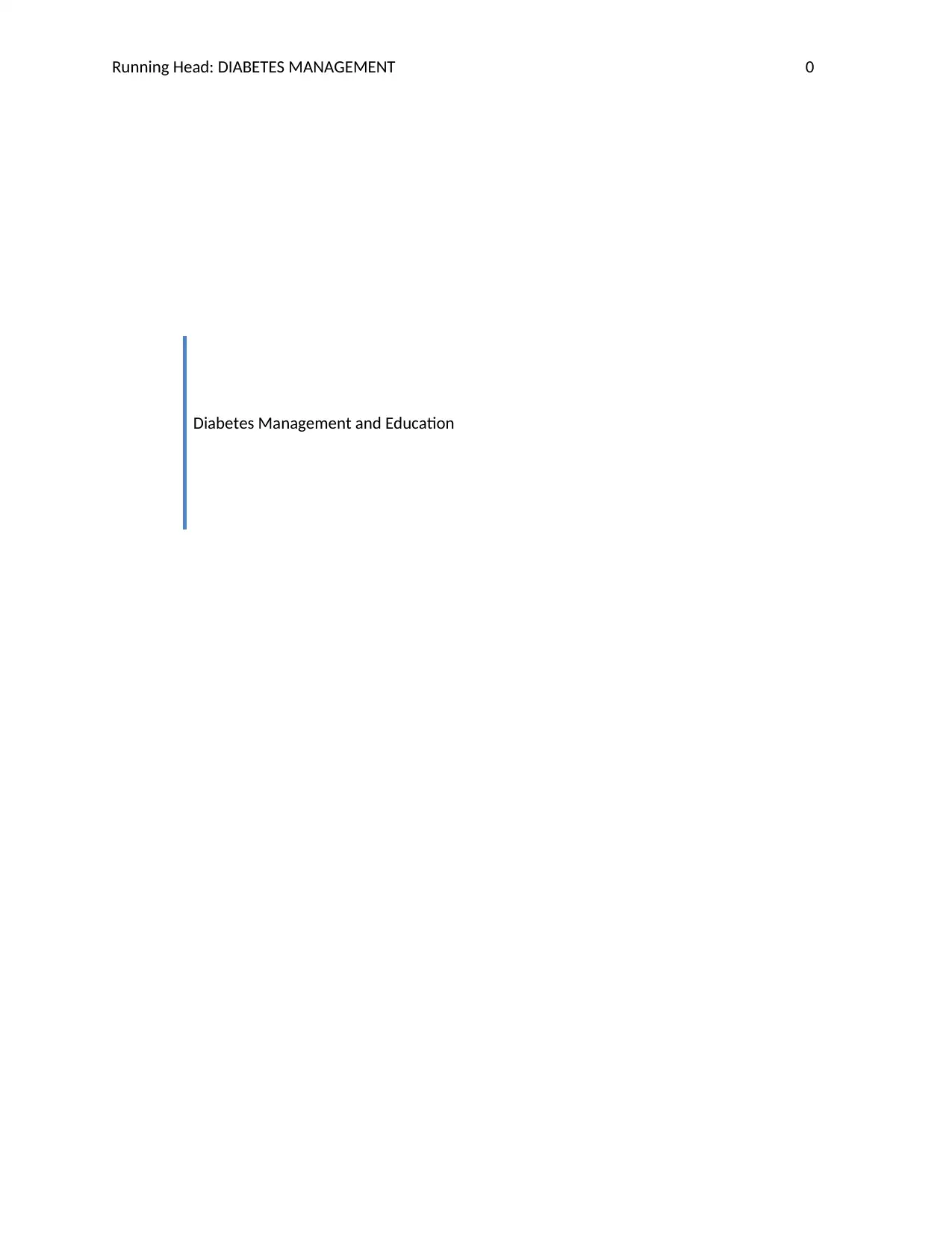
Running Head: DIABETES MANAGEMENT 0
Diabetes Management and Education
Diabetes Management and Education
Paraphrase This Document
Need a fresh take? Get an instant paraphrase of this document with our AI Paraphraser
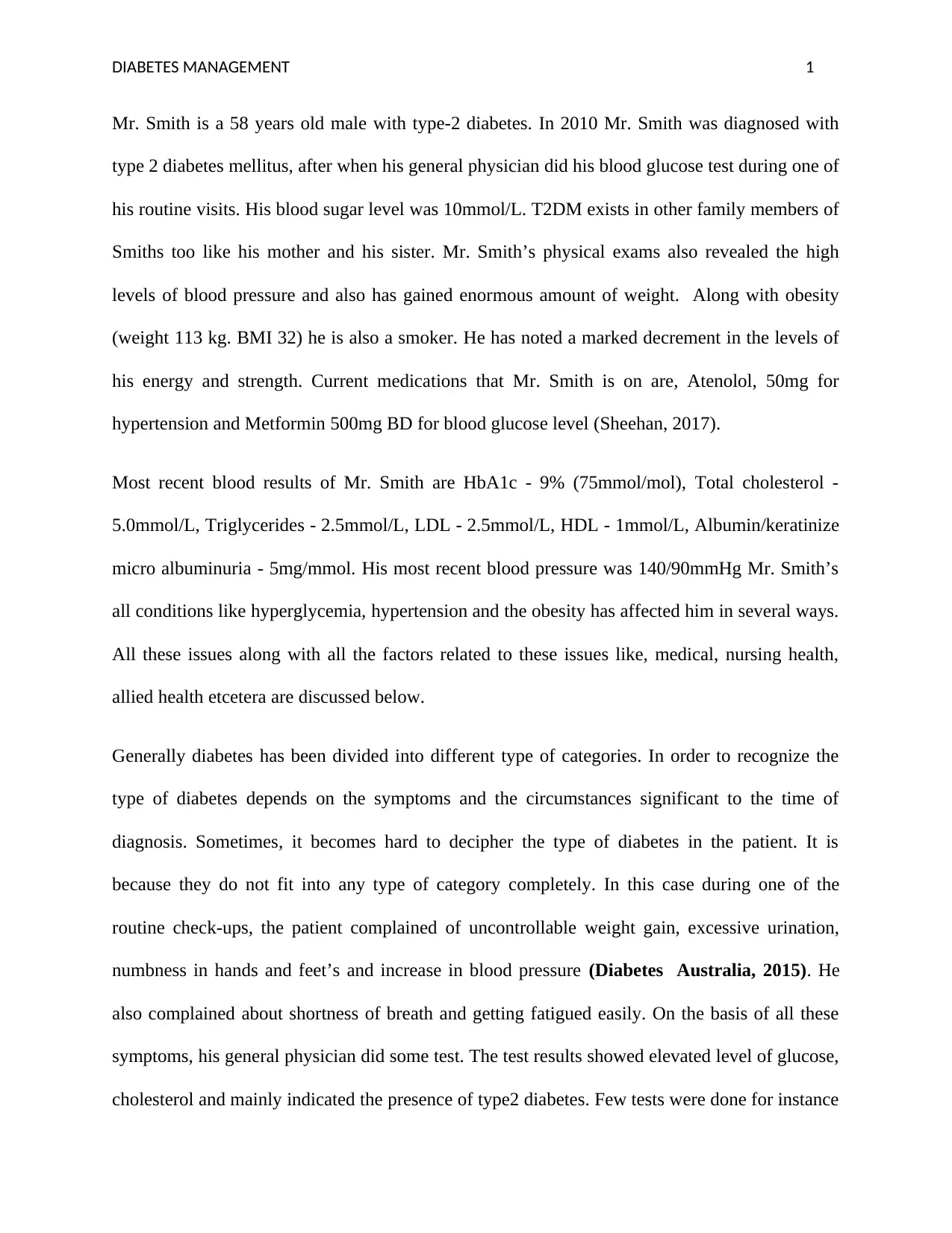
DIABETES MANAGEMENT 1
Mr. Smith is a 58 years old male with type-2 diabetes. In 2010 Mr. Smith was diagnosed with
type 2 diabetes mellitus, after when his general physician did his blood glucose test during one of
his routine visits. His blood sugar level was 10mmol/L. T2DM exists in other family members of
Smiths too like his mother and his sister. Mr. Smith’s physical exams also revealed the high
levels of blood pressure and also has gained enormous amount of weight. Along with obesity
(weight 113 kg. BMI 32) he is also a smoker. He has noted a marked decrement in the levels of
his energy and strength. Current medications that Mr. Smith is on are, Atenolol, 50mg for
hypertension and Metformin 500mg BD for blood glucose level (Sheehan, 2017).
Most recent blood results of Mr. Smith are HbA1c - 9% (75mmol/mol), Total cholesterol -
5.0mmol/L, Triglycerides - 2.5mmol/L, LDL - 2.5mmol/L, HDL - 1mmol/L, Albumin/keratinize
micro albuminuria - 5mg/mmol. His most recent blood pressure was 140/90mmHg Mr. Smith’s
all conditions like hyperglycemia, hypertension and the obesity has affected him in several ways.
All these issues along with all the factors related to these issues like, medical, nursing health,
allied health etcetera are discussed below.
Generally diabetes has been divided into different type of categories. In order to recognize the
type of diabetes depends on the symptoms and the circumstances significant to the time of
diagnosis. Sometimes, it becomes hard to decipher the type of diabetes in the patient. It is
because they do not fit into any type of category completely. In this case during one of the
routine check-ups, the patient complained of uncontrollable weight gain, excessive urination,
numbness in hands and feet’s and increase in blood pressure (Diabetes Australia, 2015). He
also complained about shortness of breath and getting fatigued easily. On the basis of all these
symptoms, his general physician did some test. The test results showed elevated level of glucose,
cholesterol and mainly indicated the presence of type2 diabetes. Few tests were done for instance
Mr. Smith is a 58 years old male with type-2 diabetes. In 2010 Mr. Smith was diagnosed with
type 2 diabetes mellitus, after when his general physician did his blood glucose test during one of
his routine visits. His blood sugar level was 10mmol/L. T2DM exists in other family members of
Smiths too like his mother and his sister. Mr. Smith’s physical exams also revealed the high
levels of blood pressure and also has gained enormous amount of weight. Along with obesity
(weight 113 kg. BMI 32) he is also a smoker. He has noted a marked decrement in the levels of
his energy and strength. Current medications that Mr. Smith is on are, Atenolol, 50mg for
hypertension and Metformin 500mg BD for blood glucose level (Sheehan, 2017).
Most recent blood results of Mr. Smith are HbA1c - 9% (75mmol/mol), Total cholesterol -
5.0mmol/L, Triglycerides - 2.5mmol/L, LDL - 2.5mmol/L, HDL - 1mmol/L, Albumin/keratinize
micro albuminuria - 5mg/mmol. His most recent blood pressure was 140/90mmHg Mr. Smith’s
all conditions like hyperglycemia, hypertension and the obesity has affected him in several ways.
All these issues along with all the factors related to these issues like, medical, nursing health,
allied health etcetera are discussed below.
Generally diabetes has been divided into different type of categories. In order to recognize the
type of diabetes depends on the symptoms and the circumstances significant to the time of
diagnosis. Sometimes, it becomes hard to decipher the type of diabetes in the patient. It is
because they do not fit into any type of category completely. In this case during one of the
routine check-ups, the patient complained of uncontrollable weight gain, excessive urination,
numbness in hands and feet’s and increase in blood pressure (Diabetes Australia, 2015). He
also complained about shortness of breath and getting fatigued easily. On the basis of all these
symptoms, his general physician did some test. The test results showed elevated level of glucose,
cholesterol and mainly indicated the presence of type2 diabetes. Few tests were done for instance
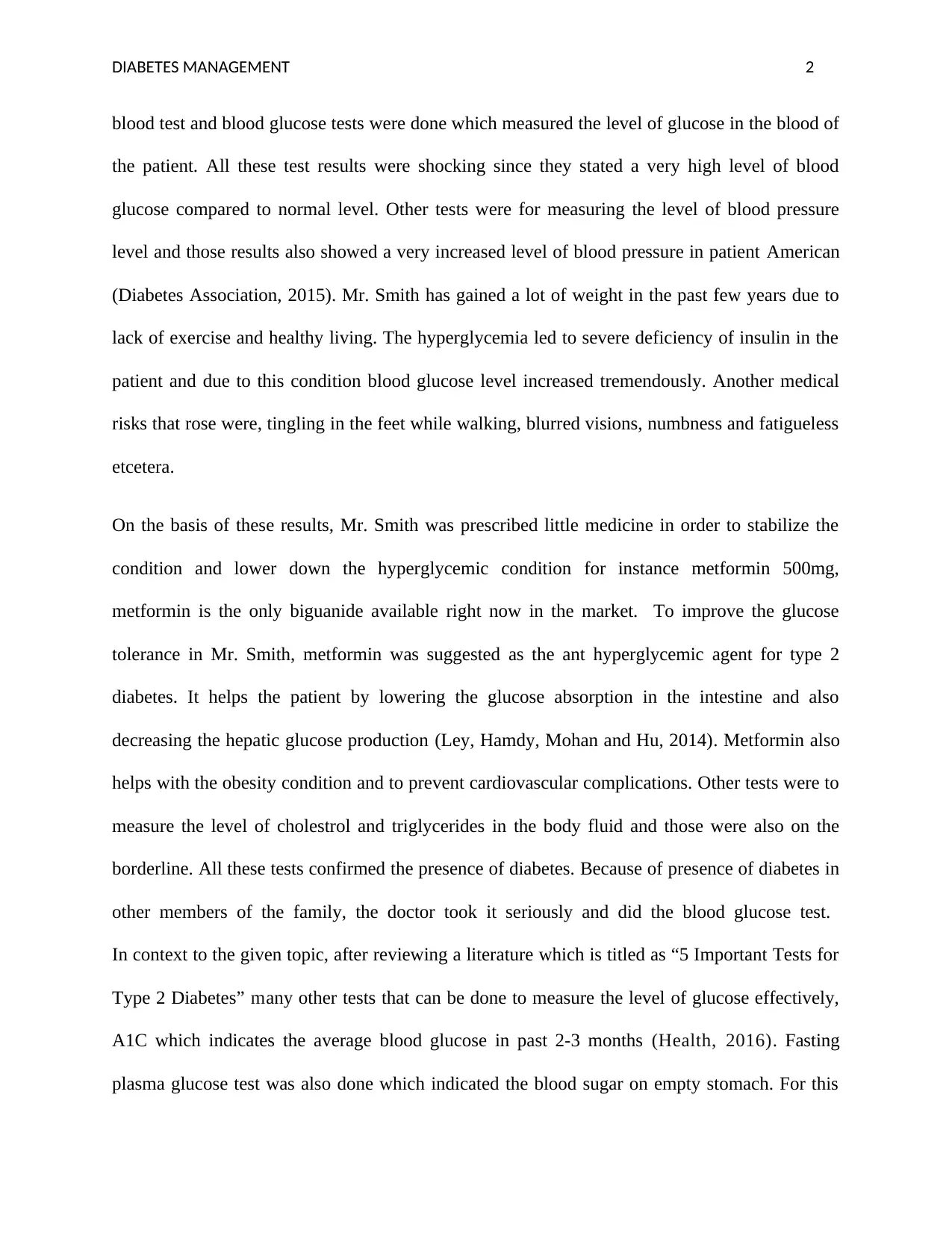
DIABETES MANAGEMENT 2
blood test and blood glucose tests were done which measured the level of glucose in the blood of
the patient. All these test results were shocking since they stated a very high level of blood
glucose compared to normal level. Other tests were for measuring the level of blood pressure
level and those results also showed a very increased level of blood pressure in patient American
(Diabetes Association, 2015). Mr. Smith has gained a lot of weight in the past few years due to
lack of exercise and healthy living. The hyperglycemia led to severe deficiency of insulin in the
patient and due to this condition blood glucose level increased tremendously. Another medical
risks that rose were, tingling in the feet while walking, blurred visions, numbness and fatigueless
etcetera.
On the basis of these results, Mr. Smith was prescribed little medicine in order to stabilize the
condition and lower down the hyperglycemic condition for instance metformin 500mg,
metformin is the only biguanide available right now in the market. To improve the glucose
tolerance in Mr. Smith, metformin was suggested as the ant hyperglycemic agent for type 2
diabetes. It helps the patient by lowering the glucose absorption in the intestine and also
decreasing the hepatic glucose production (Ley, Hamdy, Mohan and Hu, 2014). Metformin also
helps with the obesity condition and to prevent cardiovascular complications. Other tests were to
measure the level of cholestrol and triglycerides in the body fluid and those were also on the
borderline. All these tests confirmed the presence of diabetes. Because of presence of diabetes in
other members of the family, the doctor took it seriously and did the blood glucose test.
In context to the given topic, after reviewing a literature which is titled as “5 Important Tests for
Type 2 Diabetes” many other tests that can be done to measure the level of glucose effectively,
A1C which indicates the average blood glucose in past 2-3 months (Health, 2016). Fasting
plasma glucose test was also done which indicated the blood sugar on empty stomach. For this
blood test and blood glucose tests were done which measured the level of glucose in the blood of
the patient. All these test results were shocking since they stated a very high level of blood
glucose compared to normal level. Other tests were for measuring the level of blood pressure
level and those results also showed a very increased level of blood pressure in patient American
(Diabetes Association, 2015). Mr. Smith has gained a lot of weight in the past few years due to
lack of exercise and healthy living. The hyperglycemia led to severe deficiency of insulin in the
patient and due to this condition blood glucose level increased tremendously. Another medical
risks that rose were, tingling in the feet while walking, blurred visions, numbness and fatigueless
etcetera.
On the basis of these results, Mr. Smith was prescribed little medicine in order to stabilize the
condition and lower down the hyperglycemic condition for instance metformin 500mg,
metformin is the only biguanide available right now in the market. To improve the glucose
tolerance in Mr. Smith, metformin was suggested as the ant hyperglycemic agent for type 2
diabetes. It helps the patient by lowering the glucose absorption in the intestine and also
decreasing the hepatic glucose production (Ley, Hamdy, Mohan and Hu, 2014). Metformin also
helps with the obesity condition and to prevent cardiovascular complications. Other tests were to
measure the level of cholestrol and triglycerides in the body fluid and those were also on the
borderline. All these tests confirmed the presence of diabetes. Because of presence of diabetes in
other members of the family, the doctor took it seriously and did the blood glucose test.
In context to the given topic, after reviewing a literature which is titled as “5 Important Tests for
Type 2 Diabetes” many other tests that can be done to measure the level of glucose effectively,
A1C which indicates the average blood glucose in past 2-3 months (Health, 2016). Fasting
plasma glucose test was also done which indicated the blood sugar on empty stomach. For this
⊘ This is a preview!⊘
Do you want full access?
Subscribe today to unlock all pages.

Trusted by 1+ million students worldwide
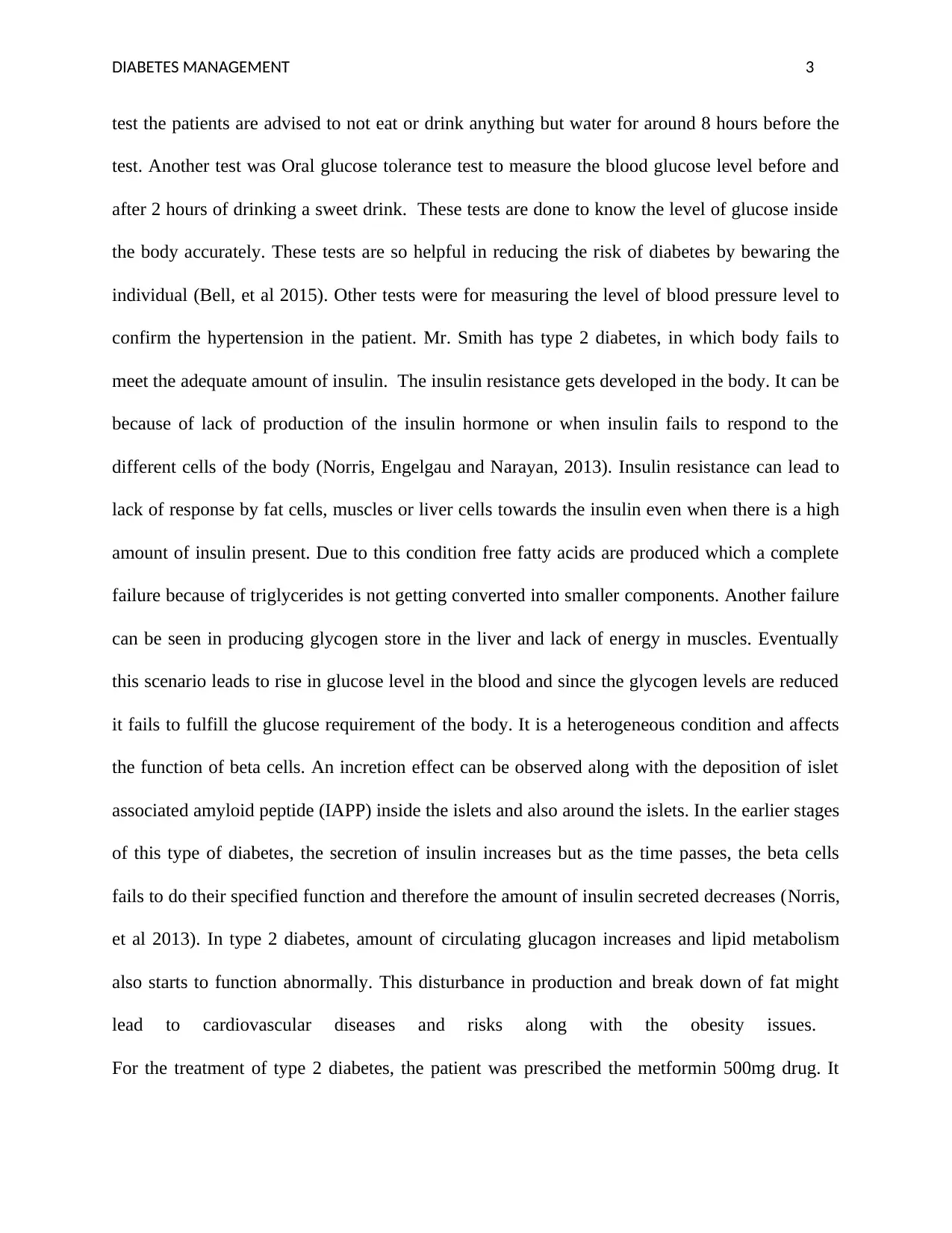
DIABETES MANAGEMENT 3
test the patients are advised to not eat or drink anything but water for around 8 hours before the
test. Another test was Oral glucose tolerance test to measure the blood glucose level before and
after 2 hours of drinking a sweet drink. These tests are done to know the level of glucose inside
the body accurately. These tests are so helpful in reducing the risk of diabetes by bewaring the
individual (Bell, et al 2015). Other tests were for measuring the level of blood pressure level to
confirm the hypertension in the patient. Mr. Smith has type 2 diabetes, in which body fails to
meet the adequate amount of insulin. The insulin resistance gets developed in the body. It can be
because of lack of production of the insulin hormone or when insulin fails to respond to the
different cells of the body (Norris, Engelgau and Narayan, 2013). Insulin resistance can lead to
lack of response by fat cells, muscles or liver cells towards the insulin even when there is a high
amount of insulin present. Due to this condition free fatty acids are produced which a complete
failure because of triglycerides is not getting converted into smaller components. Another failure
can be seen in producing glycogen store in the liver and lack of energy in muscles. Eventually
this scenario leads to rise in glucose level in the blood and since the glycogen levels are reduced
it fails to fulfill the glucose requirement of the body. It is a heterogeneous condition and affects
the function of beta cells. An incretion effect can be observed along with the deposition of islet
associated amyloid peptide (IAPP) inside the islets and also around the islets. In the earlier stages
of this type of diabetes, the secretion of insulin increases but as the time passes, the beta cells
fails to do their specified function and therefore the amount of insulin secreted decreases (Norris,
et al 2013). In type 2 diabetes, amount of circulating glucagon increases and lipid metabolism
also starts to function abnormally. This disturbance in production and break down of fat might
lead to cardiovascular diseases and risks along with the obesity issues.
For the treatment of type 2 diabetes, the patient was prescribed the metformin 500mg drug. It
test the patients are advised to not eat or drink anything but water for around 8 hours before the
test. Another test was Oral glucose tolerance test to measure the blood glucose level before and
after 2 hours of drinking a sweet drink. These tests are done to know the level of glucose inside
the body accurately. These tests are so helpful in reducing the risk of diabetes by bewaring the
individual (Bell, et al 2015). Other tests were for measuring the level of blood pressure level to
confirm the hypertension in the patient. Mr. Smith has type 2 diabetes, in which body fails to
meet the adequate amount of insulin. The insulin resistance gets developed in the body. It can be
because of lack of production of the insulin hormone or when insulin fails to respond to the
different cells of the body (Norris, Engelgau and Narayan, 2013). Insulin resistance can lead to
lack of response by fat cells, muscles or liver cells towards the insulin even when there is a high
amount of insulin present. Due to this condition free fatty acids are produced which a complete
failure because of triglycerides is not getting converted into smaller components. Another failure
can be seen in producing glycogen store in the liver and lack of energy in muscles. Eventually
this scenario leads to rise in glucose level in the blood and since the glycogen levels are reduced
it fails to fulfill the glucose requirement of the body. It is a heterogeneous condition and affects
the function of beta cells. An incretion effect can be observed along with the deposition of islet
associated amyloid peptide (IAPP) inside the islets and also around the islets. In the earlier stages
of this type of diabetes, the secretion of insulin increases but as the time passes, the beta cells
fails to do their specified function and therefore the amount of insulin secreted decreases (Norris,
et al 2013). In type 2 diabetes, amount of circulating glucagon increases and lipid metabolism
also starts to function abnormally. This disturbance in production and break down of fat might
lead to cardiovascular diseases and risks along with the obesity issues.
For the treatment of type 2 diabetes, the patient was prescribed the metformin 500mg drug. It
Paraphrase This Document
Need a fresh take? Get an instant paraphrase of this document with our AI Paraphraser
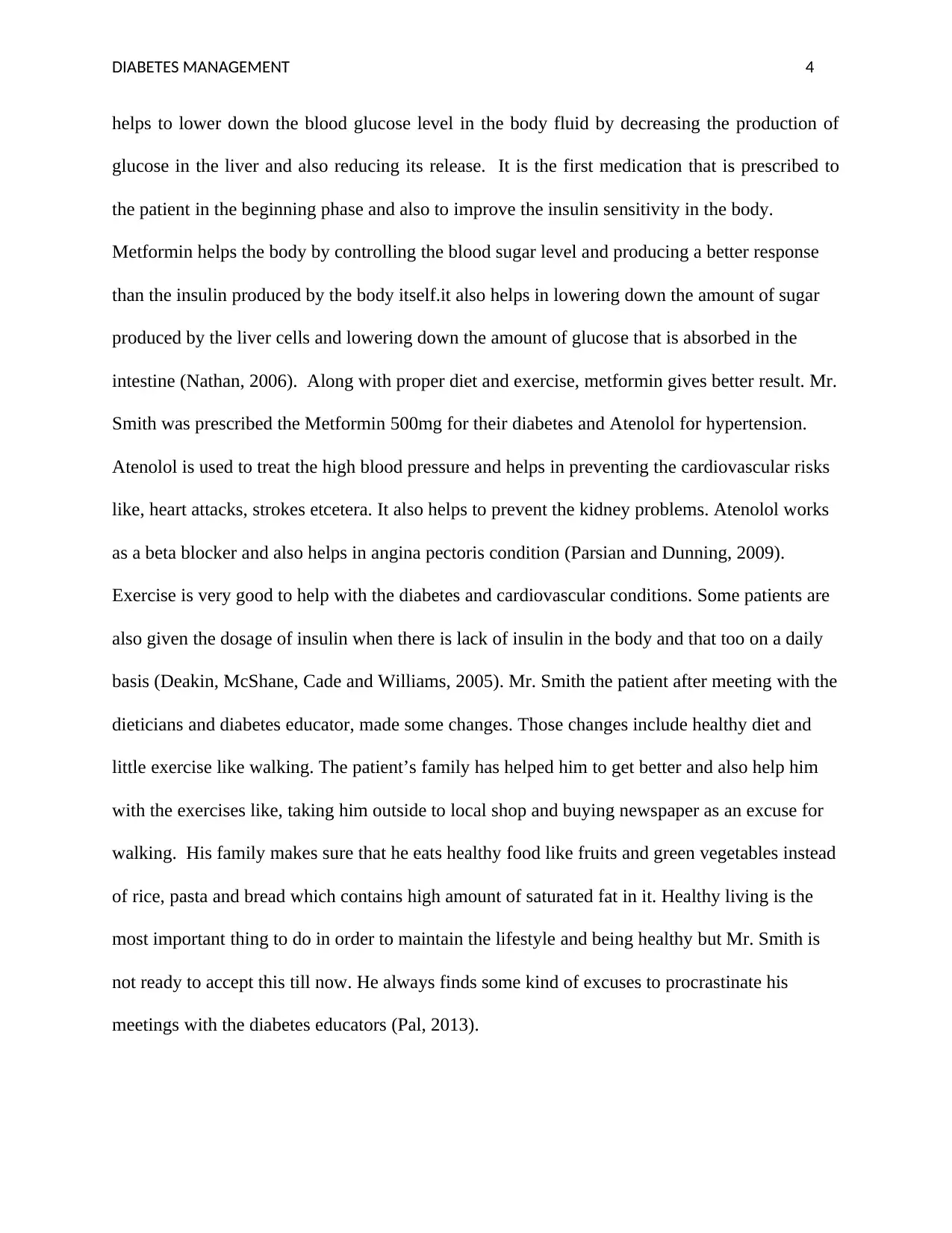
DIABETES MANAGEMENT 4
helps to lower down the blood glucose level in the body fluid by decreasing the production of
glucose in the liver and also reducing its release. It is the first medication that is prescribed to
the patient in the beginning phase and also to improve the insulin sensitivity in the body.
Metformin helps the body by controlling the blood sugar level and producing a better response
than the insulin produced by the body itself.it also helps in lowering down the amount of sugar
produced by the liver cells and lowering down the amount of glucose that is absorbed in the
intestine (Nathan, 2006). Along with proper diet and exercise, metformin gives better result. Mr.
Smith was prescribed the Metformin 500mg for their diabetes and Atenolol for hypertension.
Atenolol is used to treat the high blood pressure and helps in preventing the cardiovascular risks
like, heart attacks, strokes etcetera. It also helps to prevent the kidney problems. Atenolol works
as a beta blocker and also helps in angina pectoris condition (Parsian and Dunning, 2009).
Exercise is very good to help with the diabetes and cardiovascular conditions. Some patients are
also given the dosage of insulin when there is lack of insulin in the body and that too on a daily
basis (Deakin, McShane, Cade and Williams, 2005). Mr. Smith the patient after meeting with the
dieticians and diabetes educator, made some changes. Those changes include healthy diet and
little exercise like walking. The patient’s family has helped him to get better and also help him
with the exercises like, taking him outside to local shop and buying newspaper as an excuse for
walking. His family makes sure that he eats healthy food like fruits and green vegetables instead
of rice, pasta and bread which contains high amount of saturated fat in it. Healthy living is the
most important thing to do in order to maintain the lifestyle and being healthy but Mr. Smith is
not ready to accept this till now. He always finds some kind of excuses to procrastinate his
meetings with the diabetes educators (Pal, 2013).
helps to lower down the blood glucose level in the body fluid by decreasing the production of
glucose in the liver and also reducing its release. It is the first medication that is prescribed to
the patient in the beginning phase and also to improve the insulin sensitivity in the body.
Metformin helps the body by controlling the blood sugar level and producing a better response
than the insulin produced by the body itself.it also helps in lowering down the amount of sugar
produced by the liver cells and lowering down the amount of glucose that is absorbed in the
intestine (Nathan, 2006). Along with proper diet and exercise, metformin gives better result. Mr.
Smith was prescribed the Metformin 500mg for their diabetes and Atenolol for hypertension.
Atenolol is used to treat the high blood pressure and helps in preventing the cardiovascular risks
like, heart attacks, strokes etcetera. It also helps to prevent the kidney problems. Atenolol works
as a beta blocker and also helps in angina pectoris condition (Parsian and Dunning, 2009).
Exercise is very good to help with the diabetes and cardiovascular conditions. Some patients are
also given the dosage of insulin when there is lack of insulin in the body and that too on a daily
basis (Deakin, McShane, Cade and Williams, 2005). Mr. Smith the patient after meeting with the
dieticians and diabetes educator, made some changes. Those changes include healthy diet and
little exercise like walking. The patient’s family has helped him to get better and also help him
with the exercises like, taking him outside to local shop and buying newspaper as an excuse for
walking. His family makes sure that he eats healthy food like fruits and green vegetables instead
of rice, pasta and bread which contains high amount of saturated fat in it. Healthy living is the
most important thing to do in order to maintain the lifestyle and being healthy but Mr. Smith is
not ready to accept this till now. He always finds some kind of excuses to procrastinate his
meetings with the diabetes educators (Pal, 2013).
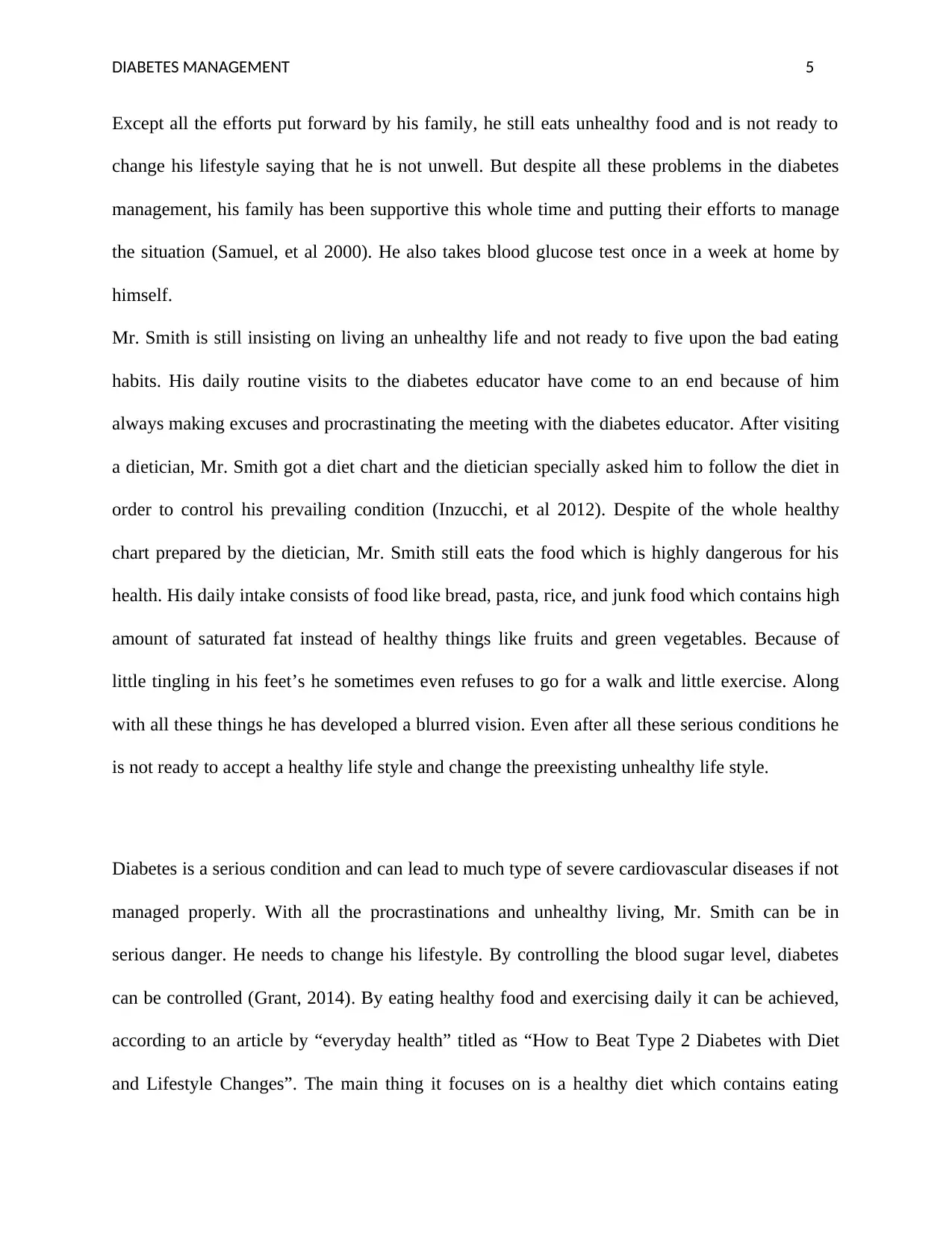
DIABETES MANAGEMENT 5
Except all the efforts put forward by his family, he still eats unhealthy food and is not ready to
change his lifestyle saying that he is not unwell. But despite all these problems in the diabetes
management, his family has been supportive this whole time and putting their efforts to manage
the situation (Samuel, et al 2000). He also takes blood glucose test once in a week at home by
himself.
Mr. Smith is still insisting on living an unhealthy life and not ready to five upon the bad eating
habits. His daily routine visits to the diabetes educator have come to an end because of him
always making excuses and procrastinating the meeting with the diabetes educator. After visiting
a dietician, Mr. Smith got a diet chart and the dietician specially asked him to follow the diet in
order to control his prevailing condition (Inzucchi, et al 2012). Despite of the whole healthy
chart prepared by the dietician, Mr. Smith still eats the food which is highly dangerous for his
health. His daily intake consists of food like bread, pasta, rice, and junk food which contains high
amount of saturated fat instead of healthy things like fruits and green vegetables. Because of
little tingling in his feet’s he sometimes even refuses to go for a walk and little exercise. Along
with all these things he has developed a blurred vision. Even after all these serious conditions he
is not ready to accept a healthy life style and change the preexisting unhealthy life style.
Diabetes is a serious condition and can lead to much type of severe cardiovascular diseases if not
managed properly. With all the procrastinations and unhealthy living, Mr. Smith can be in
serious danger. He needs to change his lifestyle. By controlling the blood sugar level, diabetes
can be controlled (Grant, 2014). By eating healthy food and exercising daily it can be achieved,
according to an article by “everyday health” titled as “How to Beat Type 2 Diabetes with Diet
and Lifestyle Changes”. The main thing it focuses on is a healthy diet which contains eating
Except all the efforts put forward by his family, he still eats unhealthy food and is not ready to
change his lifestyle saying that he is not unwell. But despite all these problems in the diabetes
management, his family has been supportive this whole time and putting their efforts to manage
the situation (Samuel, et al 2000). He also takes blood glucose test once in a week at home by
himself.
Mr. Smith is still insisting on living an unhealthy life and not ready to five upon the bad eating
habits. His daily routine visits to the diabetes educator have come to an end because of him
always making excuses and procrastinating the meeting with the diabetes educator. After visiting
a dietician, Mr. Smith got a diet chart and the dietician specially asked him to follow the diet in
order to control his prevailing condition (Inzucchi, et al 2012). Despite of the whole healthy
chart prepared by the dietician, Mr. Smith still eats the food which is highly dangerous for his
health. His daily intake consists of food like bread, pasta, rice, and junk food which contains high
amount of saturated fat instead of healthy things like fruits and green vegetables. Because of
little tingling in his feet’s he sometimes even refuses to go for a walk and little exercise. Along
with all these things he has developed a blurred vision. Even after all these serious conditions he
is not ready to accept a healthy life style and change the preexisting unhealthy life style.
Diabetes is a serious condition and can lead to much type of severe cardiovascular diseases if not
managed properly. With all the procrastinations and unhealthy living, Mr. Smith can be in
serious danger. He needs to change his lifestyle. By controlling the blood sugar level, diabetes
can be controlled (Grant, 2014). By eating healthy food and exercising daily it can be achieved,
according to an article by “everyday health” titled as “How to Beat Type 2 Diabetes with Diet
and Lifestyle Changes”. The main thing it focuses on is a healthy diet which contains eating
⊘ This is a preview!⊘
Do you want full access?
Subscribe today to unlock all pages.

Trusted by 1+ million students worldwide
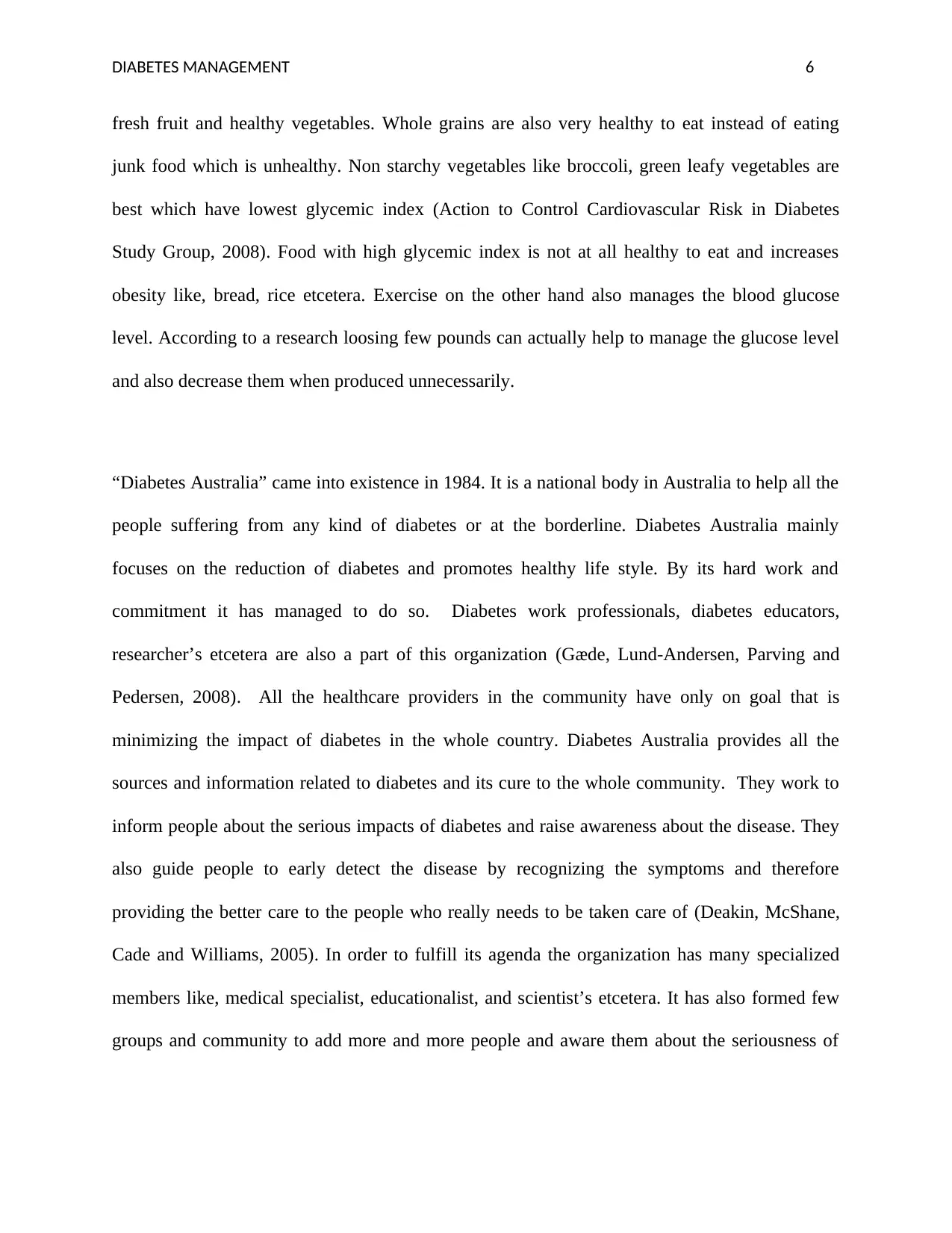
DIABETES MANAGEMENT 6
fresh fruit and healthy vegetables. Whole grains are also very healthy to eat instead of eating
junk food which is unhealthy. Non starchy vegetables like broccoli, green leafy vegetables are
best which have lowest glycemic index (Action to Control Cardiovascular Risk in Diabetes
Study Group, 2008). Food with high glycemic index is not at all healthy to eat and increases
obesity like, bread, rice etcetera. Exercise on the other hand also manages the blood glucose
level. According to a research loosing few pounds can actually help to manage the glucose level
and also decrease them when produced unnecessarily.
“Diabetes Australia” came into existence in 1984. It is a national body in Australia to help all the
people suffering from any kind of diabetes or at the borderline. Diabetes Australia mainly
focuses on the reduction of diabetes and promotes healthy life style. By its hard work and
commitment it has managed to do so. Diabetes work professionals, diabetes educators,
researcher’s etcetera are also a part of this organization (Gæde, Lund-Andersen, Parving and
Pedersen, 2008). All the healthcare providers in the community have only on goal that is
minimizing the impact of diabetes in the whole country. Diabetes Australia provides all the
sources and information related to diabetes and its cure to the whole community. They work to
inform people about the serious impacts of diabetes and raise awareness about the disease. They
also guide people to early detect the disease by recognizing the symptoms and therefore
providing the better care to the people who really needs to be taken care of (Deakin, McShane,
Cade and Williams, 2005). In order to fulfill its agenda the organization has many specialized
members like, medical specialist, educationalist, and scientist’s etcetera. It has also formed few
groups and community to add more and more people and aware them about the seriousness of
fresh fruit and healthy vegetables. Whole grains are also very healthy to eat instead of eating
junk food which is unhealthy. Non starchy vegetables like broccoli, green leafy vegetables are
best which have lowest glycemic index (Action to Control Cardiovascular Risk in Diabetes
Study Group, 2008). Food with high glycemic index is not at all healthy to eat and increases
obesity like, bread, rice etcetera. Exercise on the other hand also manages the blood glucose
level. According to a research loosing few pounds can actually help to manage the glucose level
and also decrease them when produced unnecessarily.
“Diabetes Australia” came into existence in 1984. It is a national body in Australia to help all the
people suffering from any kind of diabetes or at the borderline. Diabetes Australia mainly
focuses on the reduction of diabetes and promotes healthy life style. By its hard work and
commitment it has managed to do so. Diabetes work professionals, diabetes educators,
researcher’s etcetera are also a part of this organization (Gæde, Lund-Andersen, Parving and
Pedersen, 2008). All the healthcare providers in the community have only on goal that is
minimizing the impact of diabetes in the whole country. Diabetes Australia provides all the
sources and information related to diabetes and its cure to the whole community. They work to
inform people about the serious impacts of diabetes and raise awareness about the disease. They
also guide people to early detect the disease by recognizing the symptoms and therefore
providing the better care to the people who really needs to be taken care of (Deakin, McShane,
Cade and Williams, 2005). In order to fulfill its agenda the organization has many specialized
members like, medical specialist, educationalist, and scientist’s etcetera. It has also formed few
groups and community to add more and more people and aware them about the seriousness of
Paraphrase This Document
Need a fresh take? Get an instant paraphrase of this document with our AI Paraphraser

DIABETES MANAGEMENT 7
the following condition. Australian Diabetes provides its support, assistance, information and
products to around 1.1 million people in Australia who were diagnosed with diabetes.
the following condition. Australian Diabetes provides its support, assistance, information and
products to around 1.1 million people in Australia who were diagnosed with diabetes.
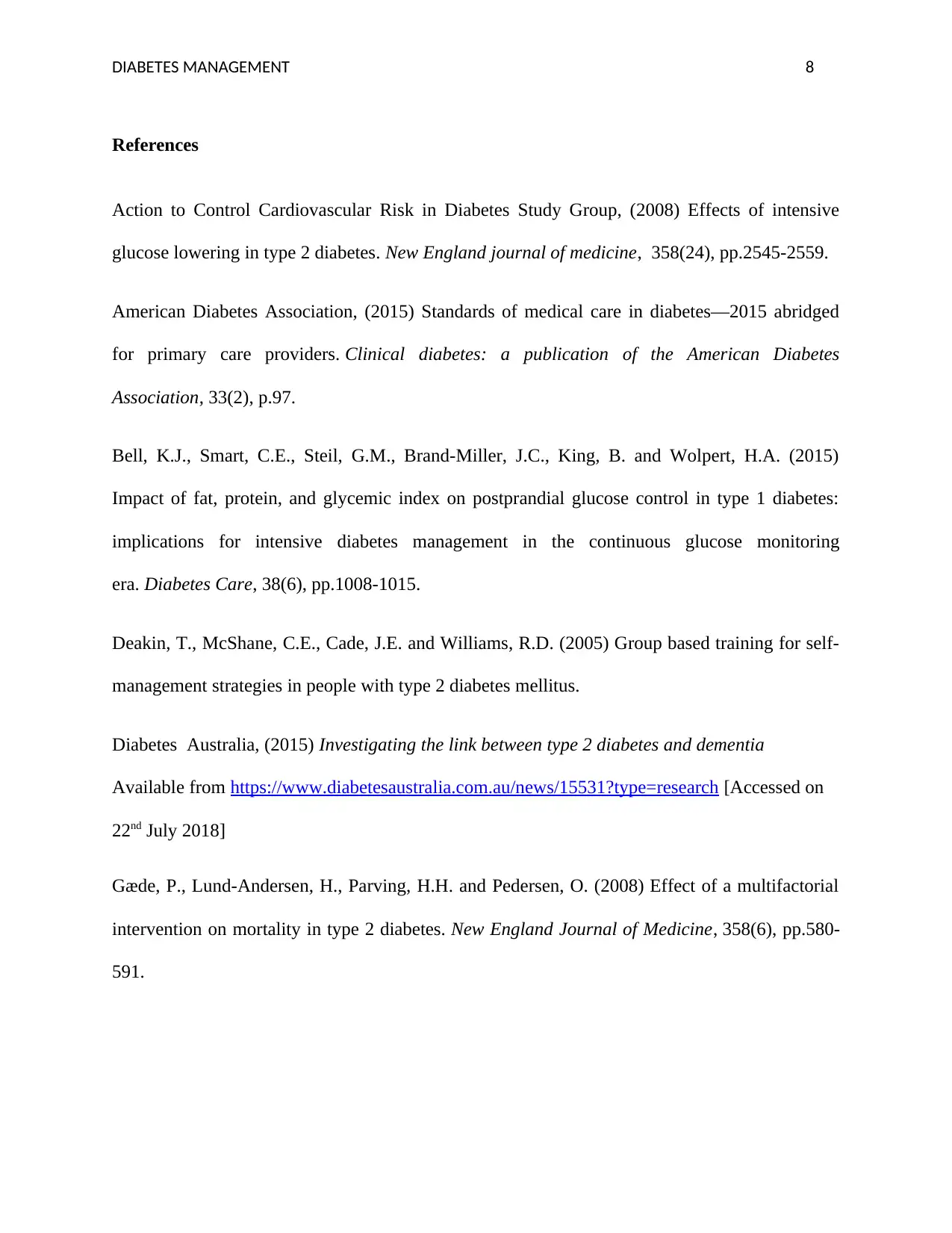
DIABETES MANAGEMENT 8
References
Action to Control Cardiovascular Risk in Diabetes Study Group, (2008) Effects of intensive
glucose lowering in type 2 diabetes. New England journal of medicine, 358(24), pp.2545-2559.
American Diabetes Association, (2015) Standards of medical care in diabetes—2015 abridged
for primary care providers. Clinical diabetes: a publication of the American Diabetes
Association, 33(2), p.97.
Bell, K.J., Smart, C.E., Steil, G.M., Brand-Miller, J.C., King, B. and Wolpert, H.A. (2015)
Impact of fat, protein, and glycemic index on postprandial glucose control in type 1 diabetes:
implications for intensive diabetes management in the continuous glucose monitoring
era. Diabetes Care, 38(6), pp.1008-1015.
Deakin, T., McShane, C.E., Cade, J.E. and Williams, R.D. (2005) Group based training for self-
management strategies in people with type 2 diabetes mellitus.
Diabetes Australia, (2015) Investigating the link between type 2 diabetes and dementia
Available from https://www.diabetesaustralia.com.au/news/15531?type=research [Accessed on
22nd July 2018]
Gæde, P., Lund-Andersen, H., Parving, H.H. and Pedersen, O. (2008) Effect of a multifactorial
intervention on mortality in type 2 diabetes. New England Journal of Medicine, 358(6), pp.580-
591.
References
Action to Control Cardiovascular Risk in Diabetes Study Group, (2008) Effects of intensive
glucose lowering in type 2 diabetes. New England journal of medicine, 358(24), pp.2545-2559.
American Diabetes Association, (2015) Standards of medical care in diabetes—2015 abridged
for primary care providers. Clinical diabetes: a publication of the American Diabetes
Association, 33(2), p.97.
Bell, K.J., Smart, C.E., Steil, G.M., Brand-Miller, J.C., King, B. and Wolpert, H.A. (2015)
Impact of fat, protein, and glycemic index on postprandial glucose control in type 1 diabetes:
implications for intensive diabetes management in the continuous glucose monitoring
era. Diabetes Care, 38(6), pp.1008-1015.
Deakin, T., McShane, C.E., Cade, J.E. and Williams, R.D. (2005) Group based training for self-
management strategies in people with type 2 diabetes mellitus.
Diabetes Australia, (2015) Investigating the link between type 2 diabetes and dementia
Available from https://www.diabetesaustralia.com.au/news/15531?type=research [Accessed on
22nd July 2018]
Gæde, P., Lund-Andersen, H., Parving, H.H. and Pedersen, O. (2008) Effect of a multifactorial
intervention on mortality in type 2 diabetes. New England Journal of Medicine, 358(6), pp.580-
591.
⊘ This is a preview!⊘
Do you want full access?
Subscribe today to unlock all pages.

Trusted by 1+ million students worldwide
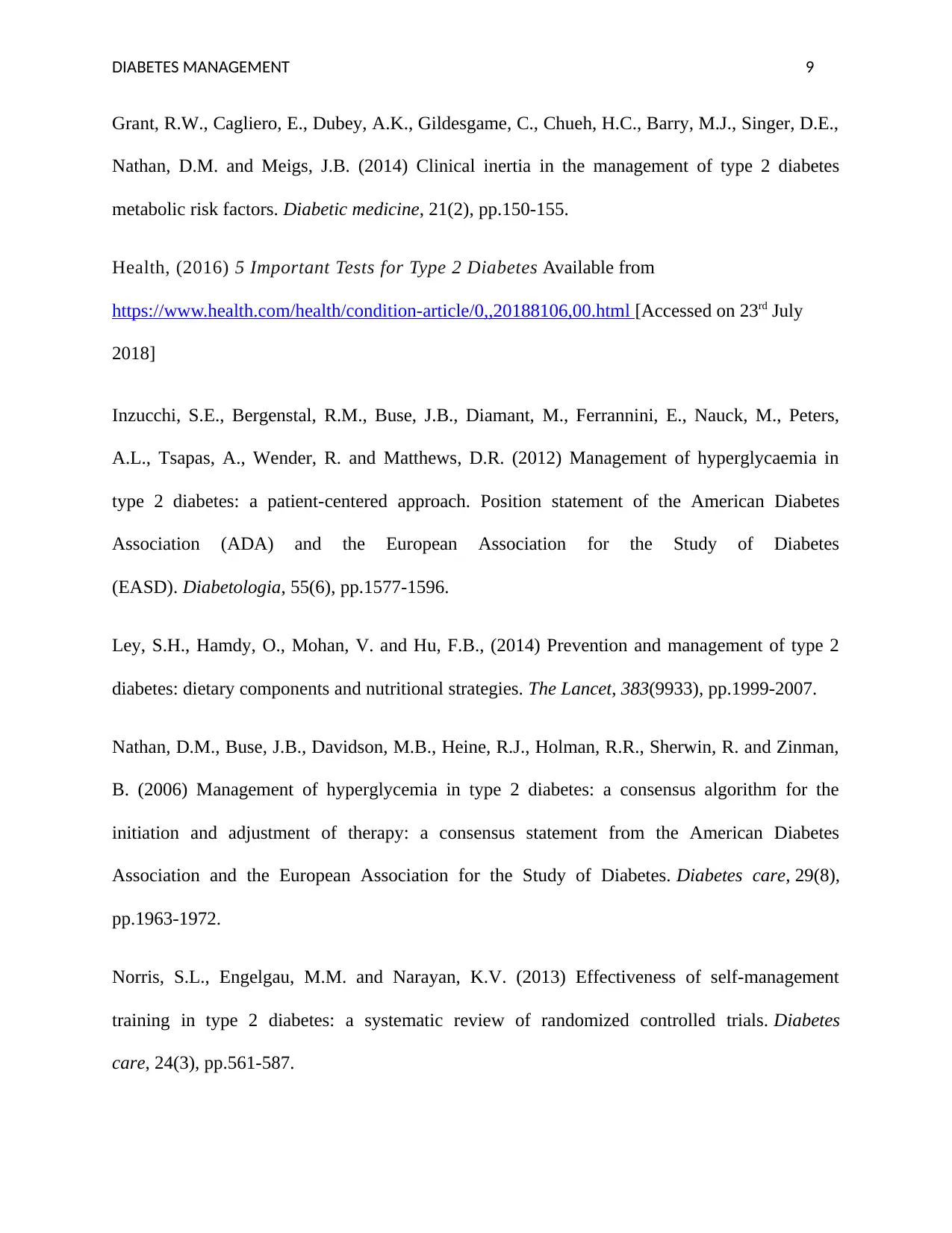
DIABETES MANAGEMENT 9
Grant, R.W., Cagliero, E., Dubey, A.K., Gildesgame, C., Chueh, H.C., Barry, M.J., Singer, D.E.,
Nathan, D.M. and Meigs, J.B. (2014) Clinical inertia in the management of type 2 diabetes
metabolic risk factors. Diabetic medicine, 21(2), pp.150-155.
Health, (2016) 5 Important Tests for Type 2 Diabetes Available from
https://www.health.com/health/condition-article/0,,20188106,00.html [Accessed on 23rd July
2018]
Inzucchi, S.E., Bergenstal, R.M., Buse, J.B., Diamant, M., Ferrannini, E., Nauck, M., Peters,
A.L., Tsapas, A., Wender, R. and Matthews, D.R. (2012) Management of hyperglycaemia in
type 2 diabetes: a patient-centered approach. Position statement of the American Diabetes
Association (ADA) and the European Association for the Study of Diabetes
(EASD). Diabetologia, 55(6), pp.1577-1596.
Ley, S.H., Hamdy, O., Mohan, V. and Hu, F.B., (2014) Prevention and management of type 2
diabetes: dietary components and nutritional strategies. The Lancet, 383(9933), pp.1999-2007.
Nathan, D.M., Buse, J.B., Davidson, M.B., Heine, R.J., Holman, R.R., Sherwin, R. and Zinman,
B. (2006) Management of hyperglycemia in type 2 diabetes: a consensus algorithm for the
initiation and adjustment of therapy: a consensus statement from the American Diabetes
Association and the European Association for the Study of Diabetes. Diabetes care, 29(8),
pp.1963-1972.
Norris, S.L., Engelgau, M.M. and Narayan, K.V. (2013) Effectiveness of self-management
training in type 2 diabetes: a systematic review of randomized controlled trials. Diabetes
care, 24(3), pp.561-587.
Grant, R.W., Cagliero, E., Dubey, A.K., Gildesgame, C., Chueh, H.C., Barry, M.J., Singer, D.E.,
Nathan, D.M. and Meigs, J.B. (2014) Clinical inertia in the management of type 2 diabetes
metabolic risk factors. Diabetic medicine, 21(2), pp.150-155.
Health, (2016) 5 Important Tests for Type 2 Diabetes Available from
https://www.health.com/health/condition-article/0,,20188106,00.html [Accessed on 23rd July
2018]
Inzucchi, S.E., Bergenstal, R.M., Buse, J.B., Diamant, M., Ferrannini, E., Nauck, M., Peters,
A.L., Tsapas, A., Wender, R. and Matthews, D.R. (2012) Management of hyperglycaemia in
type 2 diabetes: a patient-centered approach. Position statement of the American Diabetes
Association (ADA) and the European Association for the Study of Diabetes
(EASD). Diabetologia, 55(6), pp.1577-1596.
Ley, S.H., Hamdy, O., Mohan, V. and Hu, F.B., (2014) Prevention and management of type 2
diabetes: dietary components and nutritional strategies. The Lancet, 383(9933), pp.1999-2007.
Nathan, D.M., Buse, J.B., Davidson, M.B., Heine, R.J., Holman, R.R., Sherwin, R. and Zinman,
B. (2006) Management of hyperglycemia in type 2 diabetes: a consensus algorithm for the
initiation and adjustment of therapy: a consensus statement from the American Diabetes
Association and the European Association for the Study of Diabetes. Diabetes care, 29(8),
pp.1963-1972.
Norris, S.L., Engelgau, M.M. and Narayan, K.V. (2013) Effectiveness of self-management
training in type 2 diabetes: a systematic review of randomized controlled trials. Diabetes
care, 24(3), pp.561-587.
Paraphrase This Document
Need a fresh take? Get an instant paraphrase of this document with our AI Paraphraser
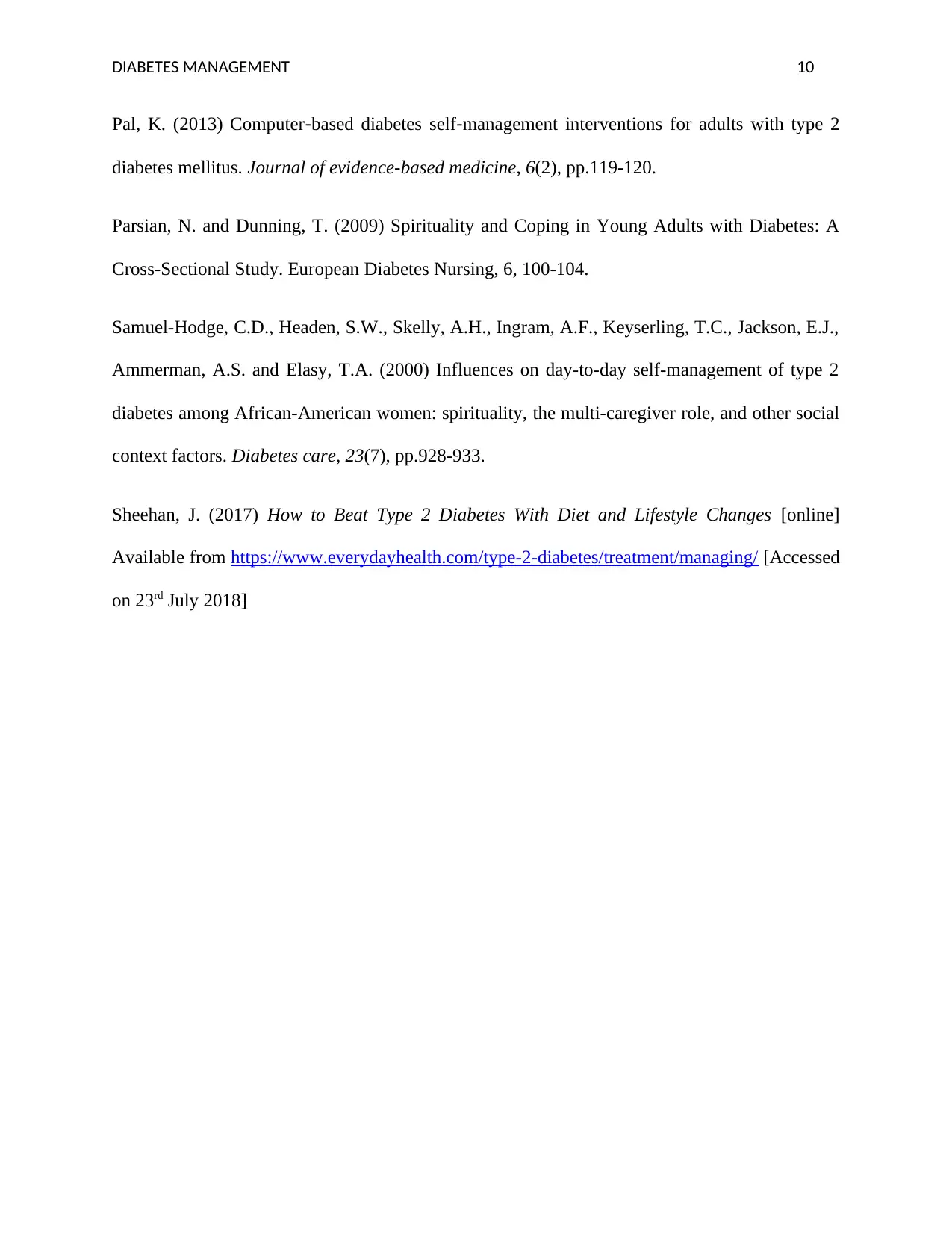
DIABETES MANAGEMENT 10
Pal, K. (2013) Computer‐based diabetes self‐management interventions for adults with type 2
diabetes mellitus. Journal of evidence-based medicine, 6(2), pp.119-120.
Parsian, N. and Dunning, T. (2009) Spirituality and Coping in Young Adults with Diabetes: A
Cross-Sectional Study. European Diabetes Nursing, 6, 100-104.
Samuel-Hodge, C.D., Headen, S.W., Skelly, A.H., Ingram, A.F., Keyserling, T.C., Jackson, E.J.,
Ammerman, A.S. and Elasy, T.A. (2000) Influences on day-to-day self-management of type 2
diabetes among African-American women: spirituality, the multi-caregiver role, and other social
context factors. Diabetes care, 23(7), pp.928-933.
Sheehan, J. (2017) How to Beat Type 2 Diabetes With Diet and Lifestyle Changes [online]
Available from https://www.everydayhealth.com/type-2-diabetes/treatment/managing/ [Accessed
on 23rd July 2018]
Pal, K. (2013) Computer‐based diabetes self‐management interventions for adults with type 2
diabetes mellitus. Journal of evidence-based medicine, 6(2), pp.119-120.
Parsian, N. and Dunning, T. (2009) Spirituality and Coping in Young Adults with Diabetes: A
Cross-Sectional Study. European Diabetes Nursing, 6, 100-104.
Samuel-Hodge, C.D., Headen, S.W., Skelly, A.H., Ingram, A.F., Keyserling, T.C., Jackson, E.J.,
Ammerman, A.S. and Elasy, T.A. (2000) Influences on day-to-day self-management of type 2
diabetes among African-American women: spirituality, the multi-caregiver role, and other social
context factors. Diabetes care, 23(7), pp.928-933.
Sheehan, J. (2017) How to Beat Type 2 Diabetes With Diet and Lifestyle Changes [online]
Available from https://www.everydayhealth.com/type-2-diabetes/treatment/managing/ [Accessed
on 23rd July 2018]
1 out of 11
Related Documents
Your All-in-One AI-Powered Toolkit for Academic Success.
+13062052269
info@desklib.com
Available 24*7 on WhatsApp / Email
![[object Object]](/_next/static/media/star-bottom.7253800d.svg)
Unlock your academic potential
Copyright © 2020–2025 A2Z Services. All Rights Reserved. Developed and managed by ZUCOL.





